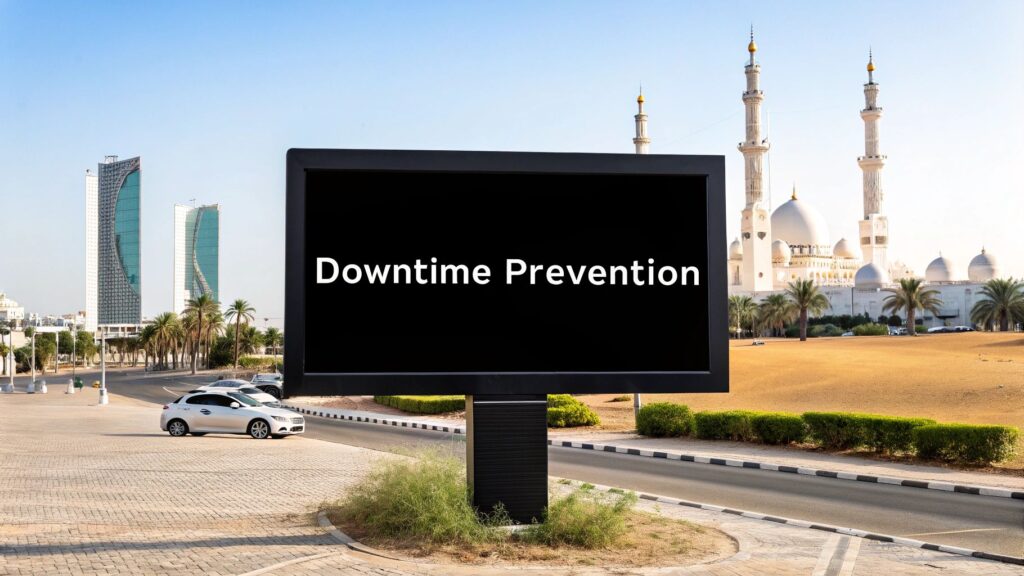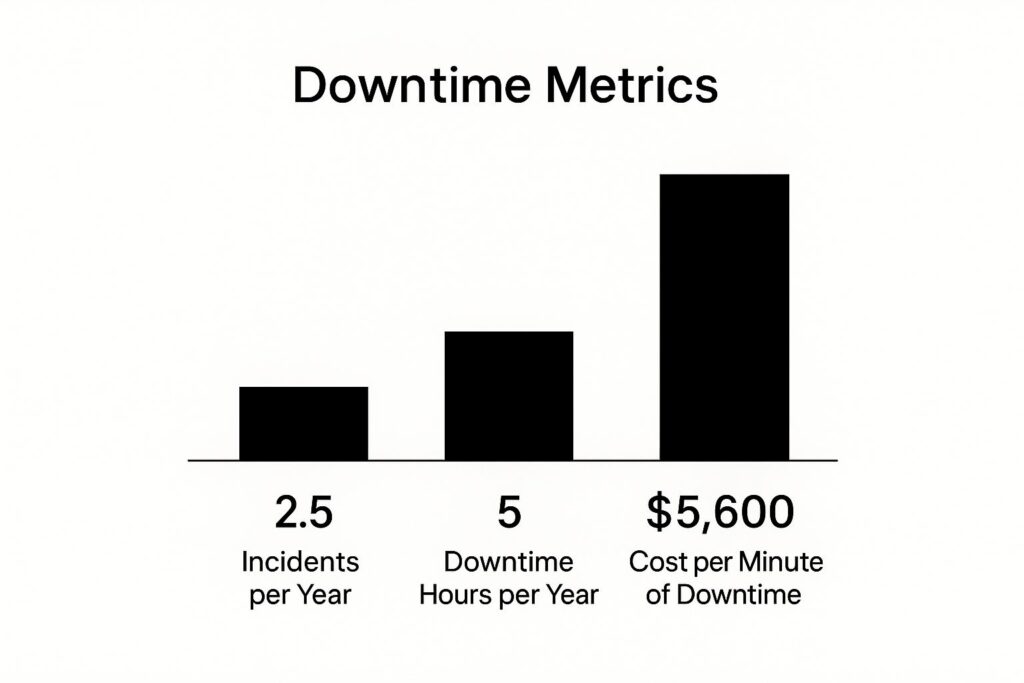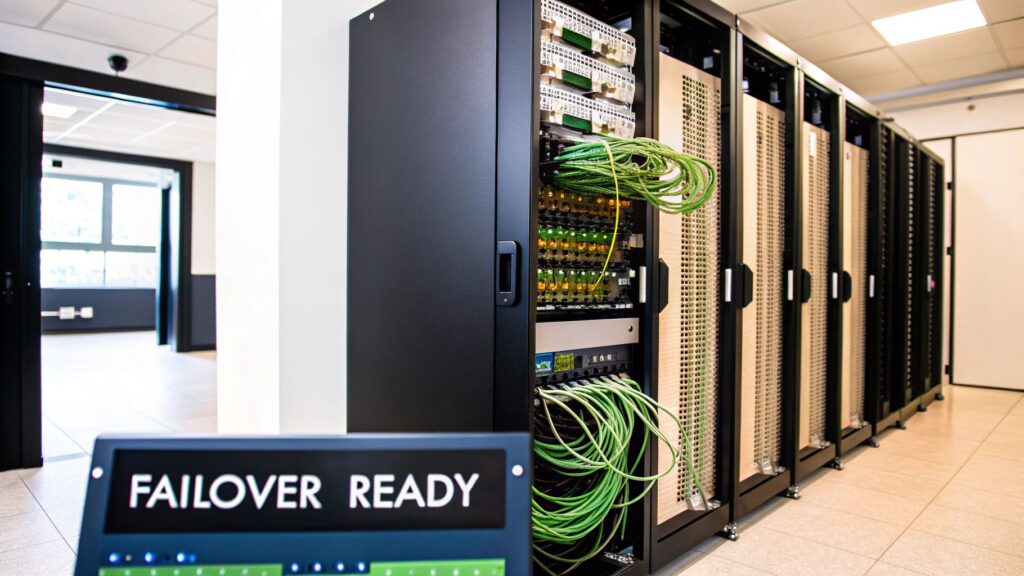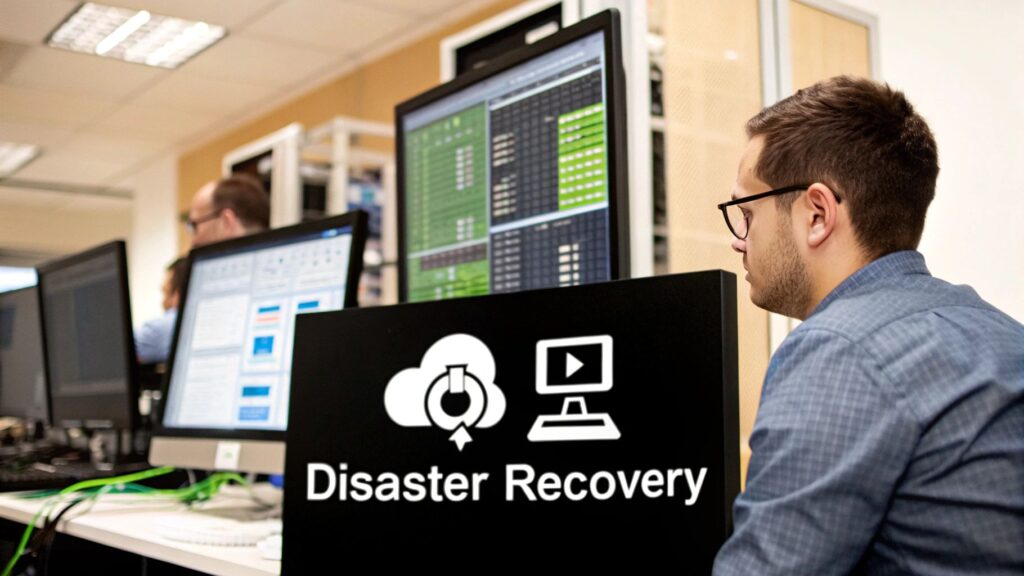
The Real Cost of Network Failures in the Arabian Peninsula
Network downtime prevention is crucial for businesses operating in the Arabian Peninsula. Outages don’t just inconvenience IT departments; they disrupt essential services and impact national economies. The region’s blend of rapid digital transformation and reliance on critical infrastructure makes it particularly susceptible to network disruptions.
Financial Impacts: More Than Just Lost Revenue
Network outages can lead to significant financial losses. When online transactions halt, supply chains break down, and customer service becomes inaccessible, businesses lose revenue. However, the costs go beyond immediate lost sales. Recovery efforts, reputational damage, and potential contractual penalties add to the financial burden.

The infographic above illustrates the severity of these incidents, showing the increasing frequency of outages, the accumulated downtime, and the alarming cost of each minute offline – a staggering $5,600. Even brief outages quickly result in substantial losses. The Arabian Peninsula’s growing dependence on digital platforms, from finance and healthcare to government services, further amplifies this risk.
To understand the varying financial impact across sectors, consider the table below:
Network Downtime Costs by Industry in the Arabian Peninsula
Comparison of hourly financial impact across different sectors based on regional economic data.
| Industry Sector | Average Hourly Cost | Additional Impact Factors | Recovery Time |
| Financial Services | $50,000 – $100,000+ | Regulatory fines, loss of investor confidence | 4-8 hours |
| Healthcare | $25,000 – $75,000 | Patient safety risks, compromised care | 8-12+ hours |
| Government Services | $10,000 – $50,000 | Disruption of public services, loss of public trust | 12-24+ hours |
| Retail/E-commerce | $5,000 – $20,000 | Lost sales, supply chain disruption | 2-4 hours |
| Tourism/Hospitality | $2,000 – $10,000 | Booking disruptions, negative guest experiences | 1-2 hours |
This table demonstrates how network downtime’s financial impact varies considerably by industry, emphasizing the need for tailored prevention and recovery strategies. Financial services, healthcare, and government services experience the highest hourly costs due to the critical nature of their operations and potential regulatory implications.
Reputational Damage and Erosion of Trust
Beyond the immediate financial impact, network failures damage a company’s reputation. In a market increasingly reliant on digital services, reliability is key. A single outage can erode customer trust and drive them to competitors offering more stable services. This is especially pertinent in the Arabian Peninsula, where online commerce and digital engagement are expanding rapidly.
Communication networks are now essential for economic and social stability in the region. While the region, particularly the GCC, has maintained relatively stable networks, the risk of disruption remains. Experiences with major power outages globally highlight the interconnectedness of infrastructure and the cascading effects of failures, emphasizing the importance of comprehensive network downtime prevention strategies. These strategies must go beyond basic infrastructure resilience and include robust regulatory frameworks that support network stability and foster public trust in digital services.
Regional Factors Exacerbating the Risk
The Arabian Peninsula’s environment adds another layer of complexity to network downtime prevention. Extreme heat stresses cooling systems vital for data center performance. Fine desert dust can infiltrate equipment, causing malfunctions and outages. The region’s vast geographical expanse also makes it difficult to provide consistent connectivity to remote locations. These factors create a unique risk profile, requiring specialized prevention approaches tailored to the region’s challenges. Businesses must adopt proactive measures, including investing in robust infrastructure, advanced monitoring systems, and comprehensive disaster recovery plans, to mitigate these risks and ensure business continuity.
Overcoming Unique Regional Infrastructure Challenges
The Arabian Peninsula presents unique challenges for maintaining network uptime. From extreme desert heat and dust storms to vast distances, organizations must implement specific measures to prevent network downtime. This means addressing the environmental factors, geographical limitations, and infrastructure vulnerabilities that can disrupt connectivity.
Battling Extreme Heat and Dust
Maintaining optimal operating temperatures for sensitive equipment is paramount. Extreme heat can push cooling systems to their limits, increasing the risk of hardware failures and network downtime. Investing in robust cooling solutions designed for high ambient temperatures and incorporating redundant cooling systems for failover protection is crucial.
Additionally, fine desert dust poses a significant threat. These particles can infiltrate equipment, causing malfunctions and outages. Implementing specialized air filtration systems and regular cleaning protocols are vital for mitigating this risk.
Bridging Geographical Divides
The vast expanse of the Arabian Peninsula creates challenges in delivering consistent connectivity to remote areas. This often necessitates creative solutions. Think wireless technologies, satellite links, and strategically placed network infrastructure to extend coverage.
Maintaining and servicing these remote installations can be difficult due to limited access. Remote monitoring capabilities and proactive maintenance schedules are essential to minimize the impact of potential issues.
Addressing Submarine Cable Vulnerabilities
International connectivity for the Arabian Peninsula relies heavily on submarine cables. However, these cables are vulnerable to damage from anchors, fishing trawlers, and even natural disasters. A single cable cut can disrupt internet access for entire countries, highlighting the need for redundant connections.
Investing in diverse cable routes and exploring alternative connectivity options, such as satellite communication, are crucial for ensuring continuous international connectivity. In recent years, the Middle East and Africa (MEA) region, while seeing significant growth in digital infrastructure, has also been prone to outages due to cable damage and power disruptions. Explore this topic further. Advanced risk management strategies and investment in resilient infrastructure are essential.
Navigating the Power Reliability Landscape
Power reliability can vary significantly across the Arabian Peninsula. Power outages are a common occurrence in some areas, requiring organizations to invest in backup power solutions. This includes properly sized UPS systems, backup generators with adequate fuel reserves, and power conditioning equipment to protect against fluctuations.
Furthermore, the region is undergoing rapid energy diversification, with increasing adoption of renewable energy sources. Integrating these sources into existing power infrastructure while managing battery performance in extreme heat requires careful planning and specialized expertise.
Balancing Development Speed and Network Resilience
The Arabian Peninsula is experiencing rapid development, with new infrastructure projects emerging at a fast pace. This rapid growth can sometimes outpace the planning required for resilient networks.
It’s crucial to integrate network downtime prevention strategies from the outset of any new infrastructure project. This includes robust network design, redundancy at every level, and proactive monitoring systems. Businesses must prioritize network resilience as a core component of their development strategies. By addressing these unique regional challenges, organizations in the Arabian Peninsula can build and maintain the highly reliable networks essential for success.
Building Resilient Networks That Actually Deliver
Network downtime can severely impact businesses, especially in the Arabian Peninsula’s evolving digital landscape. Preventing such disruptions isn’t just about implementing standard redundancy measures; it’s about building networks that can withstand real-world challenges and maintain optimal performance. Let’s delve into the architectural strategies that ensure resilience, even under pressure.
Redundancy Strategies That Go the Distance
True redundancy goes beyond simply having backup systems. It’s about ensuring these systems seamlessly activate when needed. While many organizations invest in redundant hardware, they often overlook the critical aspects of testing and maintenance. For instance, a backup power generator becomes useless without proper maintenance or an adequate fuel supply. Successful organizations in the region prioritize regular drills and simulations to validate the effectiveness of their redundancy strategies.
To build truly resilient networks, consider these key strategies:
- Diversify your resources: This includes diversifying internet service providers (ISPs), cable routes, power sources, and even hardware vendors. Relying solely on one provider in any area creates a single point of failure, increasing vulnerability to outages.
- Implement Active-Active Configurations: In active-active setups, both primary and backup systems operate concurrently. This approach minimizes switchover time during a failure, ensuring near-instantaneous recovery and uninterrupted service.
- Consider Geographic Redundancy: Geographic redundancy involves replicating infrastructure in a separate location. However, in the Arabian Peninsula, careful consideration is required. Factors such as interconnectivity between locations, power reliability at the secondary site, and potential environmental risks must be thoroughly evaluated.
To help illustrate the different redundancy approaches and their suitability for the region, let’s look at a comparison table:
To understand the nuances of implementing redundancy in the Arabian Peninsula, the following table provides a comparative analysis of various approaches. This comparison highlights the complexities, costs, effectiveness, and regional considerations associated with each method.
Redundancy Implementation Comparison for Arabian Peninsula Networks
| Redundancy Approach | Implementation Complexity | Cost Factor | Effectiveness | Regional Considerations |
| Active-Passive | Low | Moderate | Moderate | Suitable for less critical systems, offering a cost-effective redundancy solution. |
| Active-Active | High | High | High | Ideal for mission-critical applications where downtime is unacceptable, despite the higher implementation complexity and cost. |
| Geographic Redundancy | Moderate | High | High | Provides robust protection against localized disruptions, but careful site selection within the region is essential due to varying infrastructure reliability and environmental conditions. |
| Diverse Network Paths | Moderate | Moderate | High | Crucial for mitigating cable vulnerabilities and ensuring network availability even if one path fails. Often achieved by utilizing different ISPs or routing traffic through diverse geographical routes. |
This table summarizes the key differences and similarities between redundancy strategies, allowing organizations to choose the most appropriate approach based on their specific needs and regional context. Choosing the right approach involves balancing cost, complexity, and the level of resilience required.
Containing Failures with Network Segmentation
Network segmentation enhances resilience by dividing the network into smaller, isolated segments. This approach functions like a series of interconnected compartments: if one is breached, the damage is contained, preventing it from spreading to the rest of the network.
The key benefits of network segmentation include:
- Limiting the Blast Radius: Segmentation isolates failures within a specific segment, preventing cascading outages that could cripple the entire network.
- Enhanced Security: By restricting access to sensitive data and systems, segmentation bolsters security. This is particularly crucial for industries dealing with sensitive information, such as finance and healthcare.
- Simplified Troubleshooting: Isolating the affected segment streamlines troubleshooting, enabling faster problem identification and resolution.
Load Balancing for Regional Traffic Patterns
Load balancing distributes network traffic across multiple servers, preventing overload on any single server. This is vital for managing traffic spikes and ensuring consistent application performance. However, in the Arabian Peninsula, load balancing strategies need to account for regional traffic patterns.
Factors like peak usage times, high mobile device penetration, and the specific usage patterns of applications within the region must be considered. For example, e-commerce platforms may experience significant traffic surges during regional holidays or special promotions. Adjusting load balancing strategies to accommodate these fluctuations is essential for maintaining optimal performance and preventing downtime during high-demand periods. This proactive approach allows organizations to build robust and adaptable networks that can handle the unique challenges of the Arabian Peninsula while ensuring consistently high performance and minimizing the risk of network downtime.
Power Management That Works When the Grid Doesn’t

Reliable power is crucial for network uptime, especially in the Arabian Emirates. Inconsistent power can disrupt businesses and essential services. Organizations must adopt proactive power management strategies to maintain network continuity. This goes beyond simple backup power and involves a multi-layered approach.
UPS Systems: More Than Just a Battery Backup
Uninterruptible Power Supply (UPS) systems are the first line of defense against power fluctuations. Simply having a UPS is not enough. Choosing the right size UPS for your needs and the specific power conditions of your location is critical.
This means considering the power demands of your equipment, the expected length of outages, and the ambient temperature of the UAE. Overlooking these factors can lead to insufficient protection and put your network at risk.
Proper heat management is also essential for UPS battery performance. High temperatures can drastically reduce battery lifespan and efficiency. Adequate cooling and ventilation in UPS rooms are crucial for maximizing battery life and ensuring reliable backup power.
Backup Generators: Fueling Network Continuity
UPS systems offer short-term power, but backup generators are necessary for extended outages. Implementing backup generators effectively requires careful planning, particularly in the Gulf states.
Fuel quality and availability can be challenging, requiring robust fuel storage and management practices. Adhering to local environmental regulations regarding generator emissions is also vital. Ensuring your generator meets emission standards is both environmentally responsible and necessary for compliance.
Power Conditioning: Protecting Against Fluctuations
Power fluctuations, a common issue in many developing areas, can damage sensitive network equipment. Power conditioning equipment is vital for protecting your infrastructure by providing a stable and clean power supply.
This includes surge protectors, voltage regulators, and line conditioners. These devices work together to safeguard your equipment and prevent expensive damage, ensuring your network remains operational even with an unreliable power grid.
Solar Power Integration: A Sustainable Approach to Resilience
The Arabian Emirates is increasingly adopting solar power. This presents opportunities for better network downtime prevention. Integrating solar power into your infrastructure reduces reliance on the grid and creates a more resilient network.
Managing battery performance in the region’s extreme heat is crucial. This involves choosing heat-resistant battery technologies and implementing effective cooling strategies for battery storage. Early adopters are demonstrating how to achieve real power resilience while addressing these challenges.
While specific data on network downtime prevention in the UAE is limited, the broader Middle East and Africa (MEA) region faces significant challenges related to power outages and infrastructure complexities. Discover more insights about regional power challenges here. This highlights the importance of strategic planning and investment in robust infrastructure to prevent downtime. Effective power management, combining these strategies, is fundamental to network resilience in the UAE, ensuring organizations can maintain services and support economic growth and technological advancement.
Monitoring Systems That Predict Problems, Not Just Report Them
Effective network downtime prevention relies on more than just basic monitoring tools. It requires systems that deliver actionable intelligence. Many organizations in the Arabian Peninsula experience alert fatigue, overwhelmed by a constant barrage of notifications that often mask real threats. This discussion explores how leading IT teams are transitioning from reactive monitoring to proactive prediction, emphasizing solutions that provide valuable insights, not just noise.
Choosing the Right Monitoring Platform for the Region
When selecting a monitoring platform, regional considerations are paramount. Multilingual support is crucial, given the diverse workforce of the Arabian Peninsula. Equally important is a robust regional support infrastructure, including local technical experts and readily available customer service for swift troubleshooting. Platform integration with other regional systems, such as local telecommunication providers or data centers, should also be a key factor. Such integration streamlines operations and significantly improves overall network visibility.
Identifying Key Performance Indicators (KPIs) That Matter
Not all metrics offer equal value. Generic network KPIs exist, but identifying the specific indicators that genuinely predict problems in the Arabian Peninsula is critical. For instance, monitoring latency to international servers may be more vital than monitoring local server latency, given the region’s dependence on global connectivity. Understanding regional traffic patterns and peak usage times is also essential for establishing effective alert thresholds. Setting these thresholds too low generates a flood of false alarms, while setting them too high risks overlooking critical warning signs.
Automated Alert Systems: Respecting Regional Nuances
Automated alerts are indispensable, but they must be tailored to the region’s unique characteristics. Regional working patterns and cultural considerations, such as prayer times and weekends, should inform alert escalation procedures. This prevents unnecessary disruptions during non-working hours while ensuring that urgent alerts reach the appropriate personnel promptly. Alert systems with multilingual notification capabilities are also highly beneficial, accommodating the diverse linguistic landscape of the region’s IT teams.
Network Behavior Analysis and Predictive Analytics
Forward-thinking organizations are adopting network behavior analysis and predictive analytics. These tools leverage historical data to identify trends and anticipate potential issues. For instance, if network traffic routinely surges before a specific event, the system can predict future spikes and proactively allocate resources. This proactive approach averts performance degradation and outages before they impact operations. It’s similar to how navigation apps use historical data to predict traffic congestion and suggest alternative routes, saving users time and frustration.
Monitoring Remote Sites in Challenging Environments
Monitoring remote sites in the Arabian Peninsula presents unique obstacles. Limited physical access necessitates robust remote monitoring capabilities. This includes deploying remote sensors to track environmental factors like temperature and humidity, crucial for maintaining equipment performance in harsh conditions. Investing in low-bandwidth monitoring solutions for areas with limited connectivity ensures continuous oversight, even in remote locations. This proactive approach to monitoring bolsters network resilience and minimizes downtime in the Arabian Peninsula’s demanding environment.
Partnering with a trusted regional technology provider, such as FSI Technology (fsi.ae) -Trusted Cisco Partners in Dubai, provides access to valuable expertise and support, ensuring effective monitoring strategies are implemented and maintained. Their specialization in Cisco solutions and understanding of regional challenges are invaluable for establishing robust network downtime prevention strategies. Also, they provide top-tier IT AMC (Annual Maintenance Contract) services at highly competitive rates, ensuring reliable support and seamless IT operations for your business.
Creating Disaster Recovery Plans That Actually Work

Disaster recovery (DR) plans are vital for preventing network downtime. However, organizations in the Arabian Peninsula face unique challenges when developing these plans. Simply creating a plan isn’t enough; it must be practical and effective, addressing the region’s specific risks, infrastructure limitations, and cultural factors.
Conducting Region-Specific Risk Assessments
A thorough risk assessment is the foundation of any successful DR plan. This involves identifying potential threats, which in the Arabian Peninsula can range from natural disasters like sandstorms and extreme heat to geopolitical events. Organizations in coastal areas, for example, must consider the growing threat of rising sea levels and the potential disruption to submarine cable connectivity. Understanding the region’s power grid and the potential for localized outages is also crucial for developing effective backup power solutions.
Defining Realistic RTOs and RPOs
Two key components of any DR plan are the Recovery Time Objective (RTO) and Recovery Point Objective (RPO). The RTO defines the maximum acceptable downtime an organization can tolerate before services are restored, while the RPO defines the maximum acceptable data loss. Determining realistic RTOs and RPOs in the Arabian Peninsula requires careful consideration. Restoring services within minutes might be feasible in major cities but could prove significantly more challenging in remote areas with limited connectivity. Regional data storage regulations also impact RPO decisions.
Backup Strategies That Navigate Data Sovereignty
Data sovereignty regulations in the Arabian Peninsula often require data to be stored within the region. This presents a challenge for backup strategies, as organizations must find solutions that comply with these regulations while ensuring data remains readily available for recovery. Leveraging local data centers or cloud providers like Amazon Web Services (AWS) or Microsoft Azure that offer in-region storage and data replication services can help address this challenge. Balancing regulatory compliance with recovery capabilities is critical for effective network downtime prevention.
Establishing Geographically Sensible Secondary Operations Centers
A secondary operations center is essential for business continuity. However, its location requires careful consideration. Factors such as proximity to the primary site, power reliability at the secondary location, and accessibility for personnel during a disaster all affect the DR plan’s effectiveness. Locating a secondary center in a neighboring Gulf state might provide geographic redundancy but could introduce challenges related to cross-border data transfer and access during an emergency.
Cultural Factors Influencing Emergency Response
The region’s cultural context is a significant factor in DR planning, particularly when forming and training emergency response teams. Language barriers, diverse technical backgrounds, and regional working patterns require tailored training programs. Cultural sensitivity is also crucial for establishing effective communication channels within the team and with external stakeholders during a crisis.
Adapting Testing Protocols to Reflect Regional Practices
Regularly testing the DR plan is paramount. However, these tests must be adapted to reflect regional workplace practices. Public holidays, religious observances, and regional working hours can all influence the scheduling and execution of DR drills. Effective testing should involve all aspects of the plan, including backup restoration, failover procedures, and communication protocols. By considering these regional nuances, organizations in the Arabian Peninsula can develop DR plans that truly work, ensuring they are prepared for any eventuality. For specialized assistance with network downtime prevention in the region, consider partnering with FSI Technology (fsi.ae). Their expertise in Cisco solutions and understanding of regional challenges provide valuable support for organizations looking to enhance their network resilience.
Fostering a Culture Where Downtime Prevention Matters
Technical solutions are essential for preventing network downtime, but they’re only part of the equation. A company’s culture, including employee mindsets and practices, plays a crucial role. Leading organizations in the Arabian Peninsula recognize this and prioritize building cultures focused on network reliability. This involves establishing accountability and promoting proactive problem-solving across the board.
Empowering Your Team Through Training
Building a culture of uptime starts with comprehensive training programs. These programs must address the diverse technical backgrounds and linguistic needs of a multilingual workforce, a common characteristic of the Arabian Peninsula. This ensures everyone understands the importance of network uptime and their individual role in maintaining it. For instance, training can illustrate how seemingly minor actions, such as correctly labeling cables or adhering to documentation procedures, can prevent major outages.
Bridging Communication Gaps
Clear communication is paramount. Effective communication frameworks bridge the gap between technical teams and business stakeholders. This keeps everyone on the same page, from IT to upper management. Regular meetings, status reports, and even informal channels help maintain open communication and alignment. This prevents scenarios where IT is unaware of a critical business event that could strain the network, or where management underestimates the resources required for effective network maintenance.
Documentation: Overcoming Knowledge Silos
High staff turnover, prevalent in some areas of the Arabian Peninsula, can lead to knowledge silos. Valuable information often disappears when experienced employees leave. Thorough documentation practices help retain this crucial knowledge. This involves documenting network configurations, troubleshooting steps, and even the rationale behind specific technical choices. Imagine a new engineer quickly resolving a recurring network issue because the previous engineer meticulously documented the problem and its solution, saving hours of troubleshooting.
Conducting Effective Drills While Respecting Regional Work Patterns
Regular drills are essential for testing network downtime prevention plans and ensuring everyone knows their role in an emergency. However, these drills must be conducted respectfully, considering regional work patterns, religious observances, and cultural sensitivities. This ensures the drills are effective without disrupting daily operations or causing undue inconvenience. A well-prepared team will respond much more efficiently to a real outage.
Implementing Culturally Relevant Incentive Structures
Finally, incentive structures can motivate proactive problem-solving. These incentives should align with the region’s cultural values. Recognizing and rewarding employees who identify potential network issues or contribute to downtime prevention fosters a sense of shared responsibility for network reliability. This could involve a simple thank you, a small bonus, or even highlighting their contribution in a company-wide announcement.
Partnering with a regional expert like FSI Technology (fsi.ae) offers valuable support in building this culture of network uptime. Their expertise in Cisco solutions and understanding of the Arabian Peninsula’s unique challenges can help your organization implement effective training programs, communication frameworks, and incentive structures that promote a proactive approach to network downtime prevention. They understand that a well-trained and motivated team forms the foundation of a resilient network.
